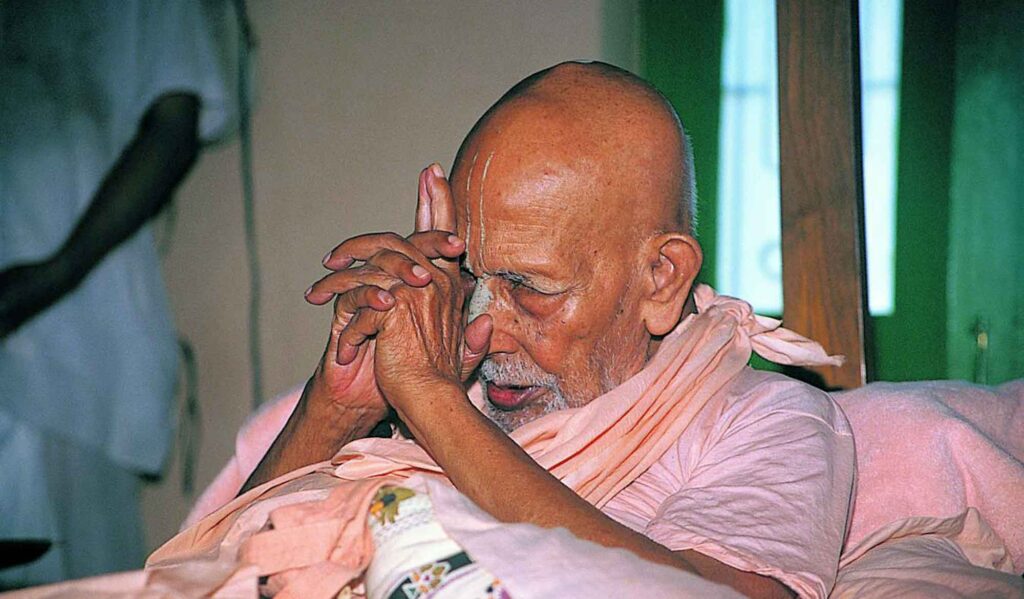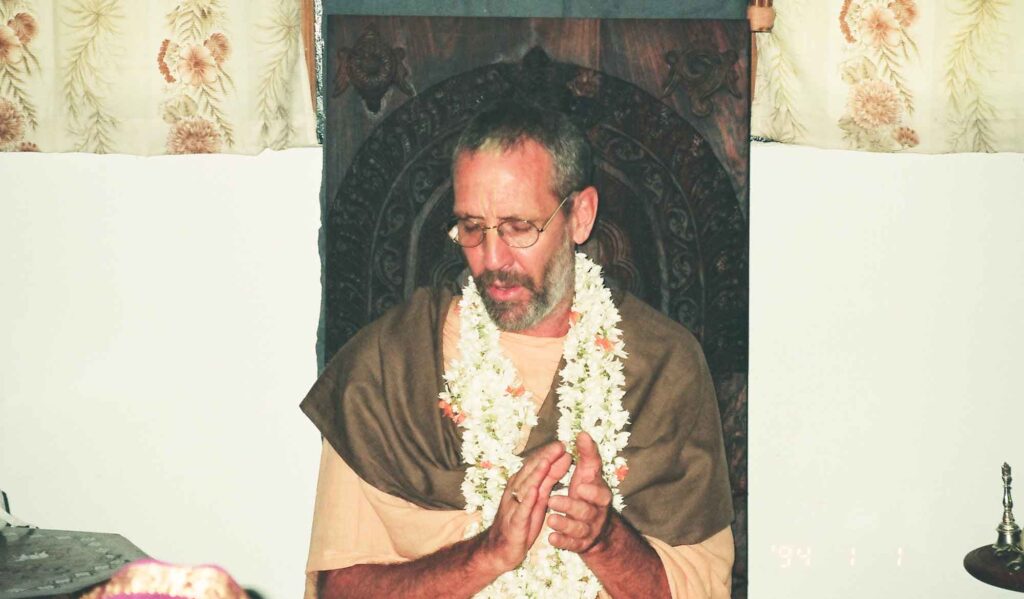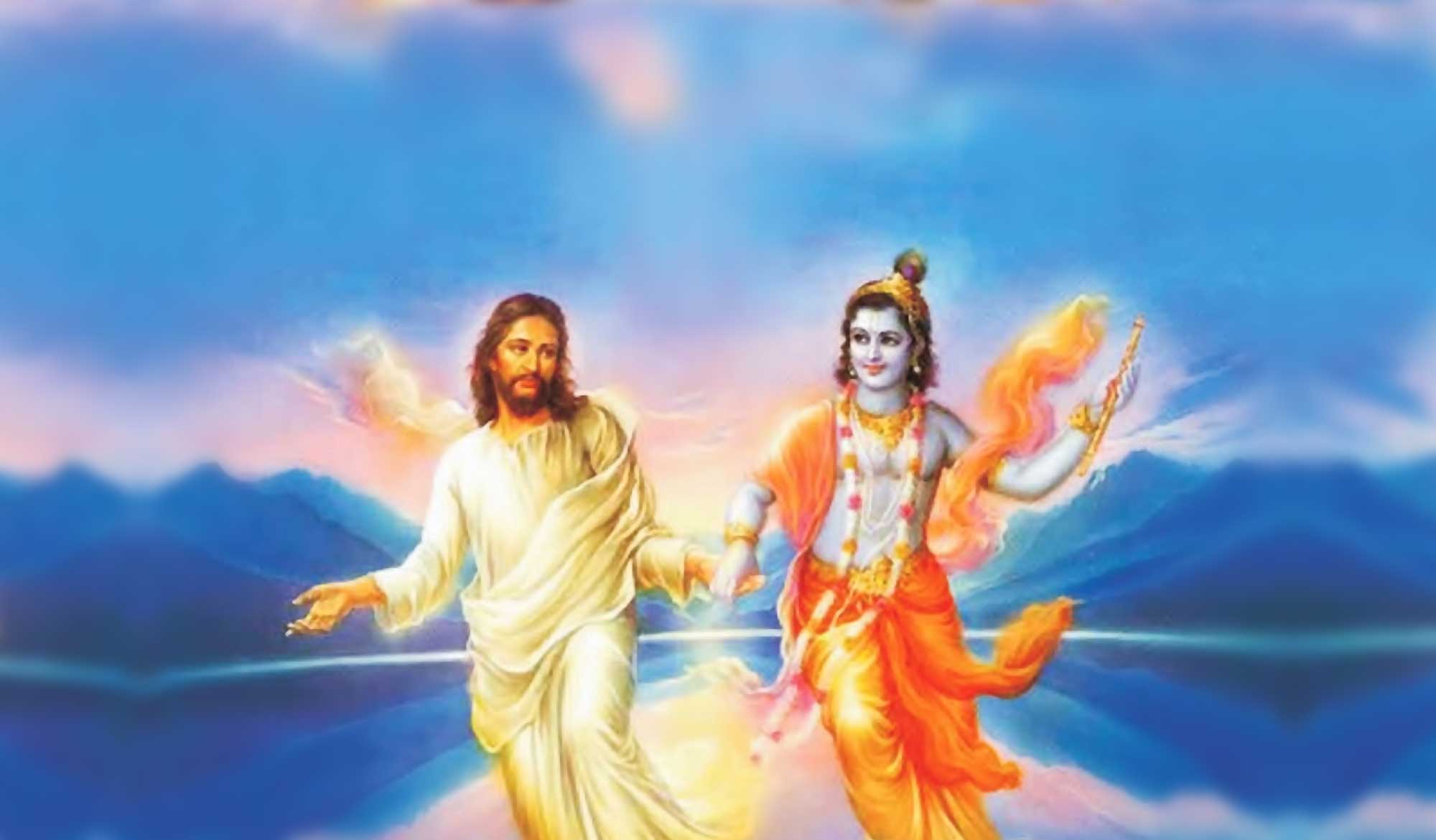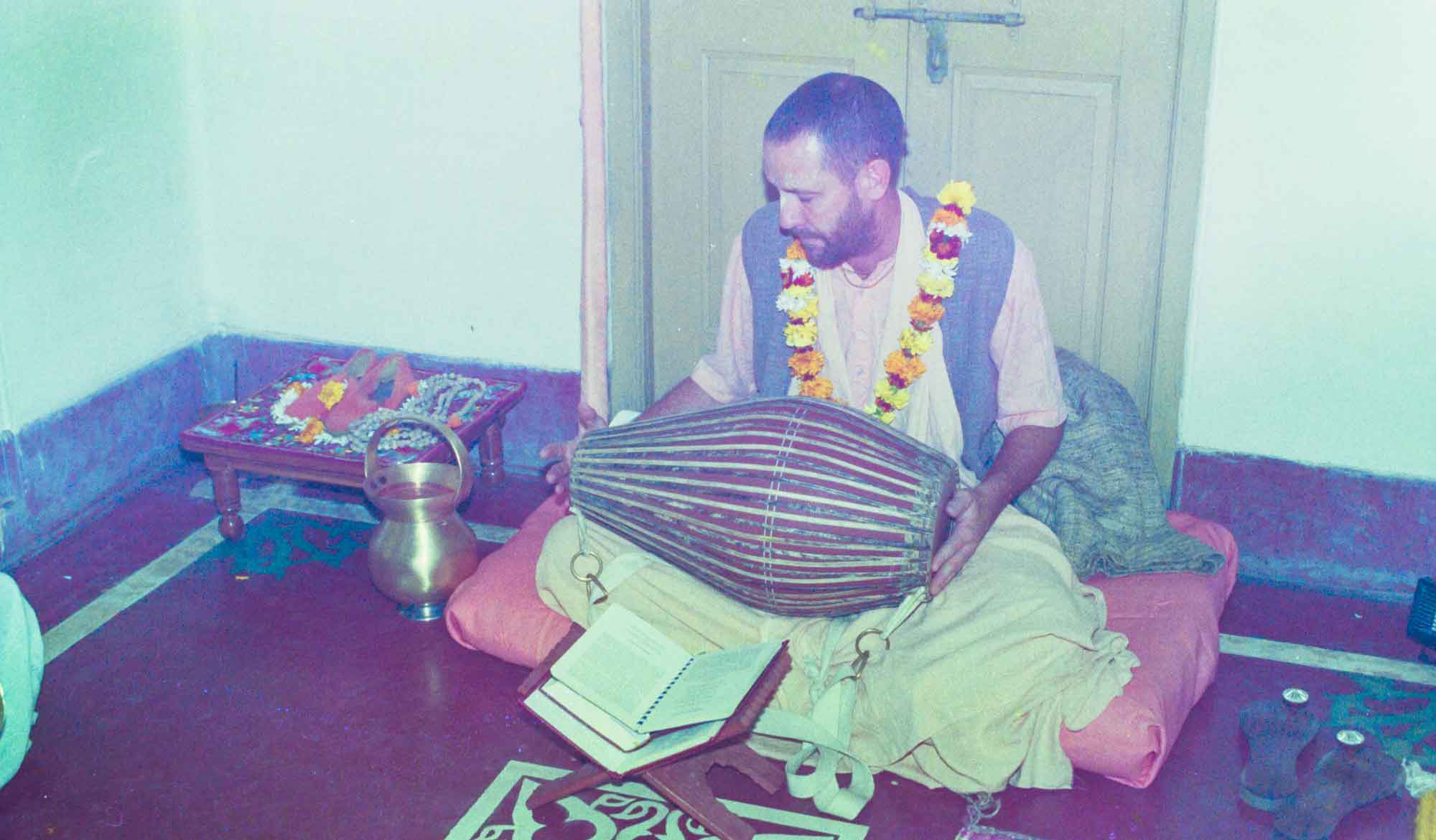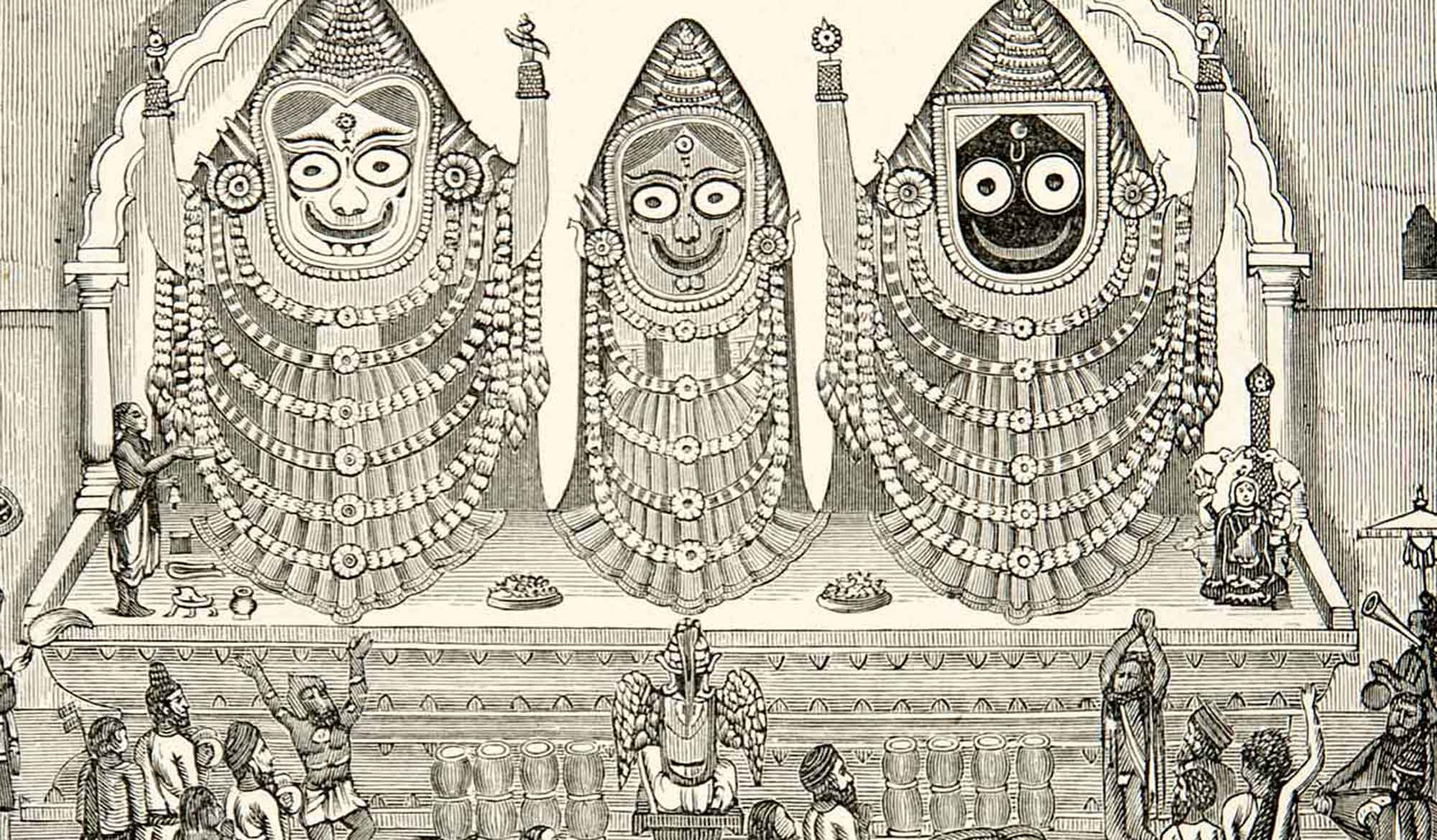by Swami B.G. Narasingha
"Guru is One" was written by Śrīla B.G. Narasiṅgha Mahārāja in 1998. This article discusses the principle of akhaṇḍa-guru-tattva, the relative side of Śrī Guru, and touches upon the meaning of the guru-gāyatrī.
The meaning of the phrase, ‘Guru is one’ is derived from the Sanskrit statement akhaṇḍa-guru-tattva. This means the undivided (akhaṇḍa) principle of the guru-tattva. This undivided guru-tattva manifests in three aspects, namely caitya-guru, dīkṣā-guru, and śikṣā-guru respectively. Caitya-guru is the Supersoul within the heart of the living entity. Dīkṣā-guru and śikṣā-guru are the two kinds of gurus appearing externally as pure devotees of the Supreme Lord. The dīkṣā and śikṣā-gurus are considered equal manifestations of Kṛṣṇa because they manifest to take the disciple back to Godhead. The individuality of the dīkṣā and śikṣā–gurus exists as Vaiṣṇavas but in purpose they are one – they are equal manifestations of Kṛṣṇa and therefore, they are said to be ‘one’.
The position of the bona-fide guru in Kṛṣṇa consciousness is realized by a bona fide disciple in stages according to the disciple’s subjective achievement. First the disciple may realize the guru to be the representative of Kṛṣṇa. The next higher stage is that the disciple realizes that the guru is a manifestation of Baladeva Prabhu or Śrī Nityānanda Prabhu. Baladeva-tattva is the energy of the Supreme Lord that manifests the pastimes or līlās of the Lord. Baladeva Prabhu manifests directly as Śrī Nityānanda Prabhu to canvas the conditioned living entities to become engaged in the Lord’s transcendental service. Canvassing on behalf of the Supreme Lord is the work of Śrī Gurudeva and therefore he is recognized as the manifestation of Baladeva Prabhu or Śrī Nityānanda Prabhu.
Baladeva Prabhu, or Śrī Nityānanda Prabhu, is the ultimate guru principle (guru-tattva) for all devotees in dāsya, sakhya, and vātsalya-rasa in both kṛṣṇa-līlā and gaura-līlā. According to the disciple’s advancement in rasa–tattva the disciple will realize that Śrī Gurudeva is a leader of a particular group of eternal servitors of the Supreme Lord.
The next higher realization of the disciple is that the guru is the leader among the mādhurya-rasa section as one of the maidservants (either sakhī or mañjarī) of Śrīmatī Rādhārāṇī. Śrīmatī Rādhārāṇī is the highest figure in the mādhurya-rasa section for She is the only one who knows how to satisfy the transcendental senses of Śrī Kṛṣṇa. When this understanding develops in the heart of a bone fide disciple he soon realizes that Śrīmatī Rādhārāṇī Herself has directly taken the position of Śrī Gurudeva. The highest concept of guru-tattva revealed by Śrīla Rūpa Gosvāmī and similar eternal servants of Śrī Caitanya Mahaprabhu was that Śrīmatī Rādhārāṇī is the ultimate guru. Rādhārāṇī is the master of loving exchanges – even Śrī Kṛṣṇa is Her beloved student in such matters. Therefore, in the last stage of realization in Kṛṣṇa consciousness the disciple realizes Śrī Gurudeva to be a direct manifestation of Śrīmatī Rādhārāṇī.
That Śrī Gurudeva is the manifestation of Śrīmatī Rādhārāṇī is the purport of Viśvanātha Cakravartī Ṭhākura’s verse, sākṣād-dharitvena samasta-śāstraiḥ– “The spiritual master is the dearmost servant of Śrī Hari, being the non-different form of the Supreme Lord”.
The dearmost servant of Kṛṣṇa (Śrī Hari) is indeed Śrīmatī Rādhārāṇī and the non-different form of the Supreme Lord is also Śrīmatī Rādhārāṇī. Rādhā and Kṛṣṇa are the One Absolute Truth manifest in two for the purpose of enjoying transcendental pastimes.
rādhā kṛṣṇa-praṇaya-vikṛtir hlādinī śaktir asmād
ekātmānāv api bhuvi purā deha-bhedaṁ gatau tau
caitanyākhyaṁ prakaṭam adhunā tad-dvayaṁ caikyam āptaṁ
rādhā-bhāva-dyuti-suvalitaṁ naumi kṛṣṇa-svarūpam
“The loving affairs of Rādhā-Kṛṣṇa are transcendental manifestations of the Lord’s internal pleasure-giving potency. Although Rādhā and Kṛṣṇa are one in Their identity, They have separated Themselves eternally. Now these two transcendental identities have again united in the form of Śrī Kṛṣṇa Caitanya. I bow down to Him, who has manifested Himself with the sentiment and complexion of Śrīmatī Rādhārāṇī although He is Kṛṣṇa Himself.” (C.c. Ādi 1.1.5)
Following the above thought Śrī Gurudeva may also be realized as gaura-tattva or non-different from Śrī Caitanya Mahaprabhu. In this case the disciple ultimately realizes that Śrī Gurudeva is a direct manifestation of Śrī Gadādhara Paṇḍita who is the bhava or the manifest emotions of Śrīmatī Rādhārāṇī.
dvijendra-vṛnda-vandya-āada-yugma-bhakti-vardhakaṁ
nijeṣu rādhikātmatā-vapuḥ-prakāśanāgraham
aśeśa-bhakti-śāstra-śikṣayojjvalāmṛta-pradaṁ
bhajāmy ahaṁ gadādharam supaṇḍitam guruṁ prabhum
“I worship the greatly learned spiritual master, Śrīla Gadādhara Prabhu, who expands the mellows of devotional service and whose lotus feet are worshipped by the kings of the brāhmaṇas. Among his confidential associates, he reveals his actual form as Śrīmatī Rādhārāṇī. He distributes the nectar of the ecstatic mellow of the gopīs conjugal love, strictly following the instructions of all the devotional scriptures.” (Śrī Gadādharāṣṭakam 6)
The above mentioned points of guru-tattva are all relative realizations of the position of the guru according to the disciple’s advancement in Kṛṣṇa consciousness. This is the Gauḍīya siddhānta of the guru-tattva as revealed by previous ācāryas in our paramparā.
The position of the guru is relative according to the disciple’s realization but in all cases the guru means ‘Kṛṣṇa’. The position of guru in terms of the internal service position of the disciple becomes more and more specific as the disciple makes advancement in Kṛṣṇa consciousness but the same akhaṇḍa-guru-tattva (undivided principle) remains throughout. Guru is one.
Everything in the Absolute World is also Absolute. Every particle of the Infinite is also Infinite but to taste the spiritual variegatedness in the Absolute World it is necessary to develop transcendental discrimination.
Śrīla Prabhupāda used to say, “Guru means to repeat the words of Kṛṣṇa without adding one’s own interpretation and therefore guru cannot be two.”
Kṛṣṇa says, ācāryaṁ māṁ vijānīyān – “One should know the ācārya as Myself.” (Bhāg. 11.17.27). This verse although generally taken literally to mean that the guru is non-different from Kṛṣṇa also indicates that the guru is non-different than Śrīmatī Rādhārāṇī. Indeed, the very ‘Self’ of Śrī Kṛṣṇa is Śrīmatī Rādhārāṇī.
Although the guru is in most cases a jīva (jīva-tattva), he is not to be considered as such. His position is two-fold. As a Vaiṣṇava he is considered a jīva but the disciple is not so much concerned with that position. The disciple is mainly concerned with the delegation of Kṛṣṇa manifest in Gurudeva and that is the guru-tattva. So the guru’s position is two-fold – he is jīva–tattva and he is guru-tattva. We do not say that Gurudeva is jīva-tattva, rather we say that Gurudeva is guru-tattva or ācārya-tattva. In this way the disciple always keeps the conception of Śrī Gurudeva above that of the ordinary human being.
Frequently devotees do not make these discriminations but this is due to their not diving deep within the ocean of Kṛṣṇa consciousness. Madhyama-adhikārī means the plane of careful and accurate discrimination. Such discrimination is necessary in order to reach the stage of uttama–adhikārī (first class devotee).
On Ekādaśī we may offer prasādam with grains to a photo of Gurudeva on the altar while engaged in worshipping the Deity of Rādhā and Kṛṣṇa, but in his room on that same day we only offer Gurudeva standard Ekādaśī prasādam. While performing worship, the disciple sees no difference between guru and Kṛṣṇa, but while rendering personal service to Śrī Gurudeva, the disciple makes a discrimination in order to please Gurudeva, understanding that he considers himself a Vaiṣṇava (servant of the Lord) and not the Lord directly. In the event that a guru declares himself to be Kṛṣṇa it becomes clear that he has no actual knowledge of the science of Kṛṣṇa consciousness. A bona-fide guru never claims to be Kṛṣṇa.
It is standard in Gauḍīya sampradayā that tulasī leaves are only offered to the lotus feet of Kṛṣṇa (viṣṇu-tattva) but the disciple understanding that the guru’s heart is one with Kṛṣṇa, places a tulasī leaf on the chest of Śrī Gurudeva while performing worship.
The oneness of guru is to be meditated on as prescribed in the guru-mantra (aiṁ gurave namaḥ) and the guru-gāyatrī – “I respectfully dedicate my heart and soul to the holy service of Śrī Śrī Rādhā-Kṛṣṇa through service to Śrī Gurudeva, who is a non-different manifestation of Their mercy.”
In the guru-gāyatrī, the word kṛṣṇānandāya indicates the internal identity of the guru in kṛṣṇa-līlā. Sometimes the word gaura-priyātva is also used in the guru-gāyatrī and this indicates the identity of the guru in gaura-līlā. Kṛṣṇa-līlā and gaura-līlā are also considered to be one or non-different.
The meaning of kṛṣṇānandāya is threefold:
(1) Kṛṣṇānanda means to meditate on that guru whose entire happiness in life is Kṛṣṇa, or that guru whose heart is full of the beauty of ecstatic love for Kṛṣṇa.
(2) Kṛṣṇānanda means to meditate on that guru who gives pleasure to his dearmost Lord Kṛṣṇa through his pure devotional service.
(3) In the word kṛṣṇānanda, kṛṣṇa is Śrī Kṛṣṇa and ānanda is hlādinī, Śrīmatī Rādhārāṇī, so kṛṣṇānandāya means meditation on Śrī Gurudeva who is the representative of both Rādhā and Kṛṣṇa combined. These three aspects of the term kṛṣṇānandāya may be applied to gurus.
The term gaura-priyātva is another significant definition of Śrī Gurudeva. The word gaura-priya has two connotations:
(1) One who is beloved to Gaura.
(2) One in whose life Śrī Gaura is the dearmost object of devotion.
According to the realization of pure devotees gaura-priya and kṛṣṇa-priya are parallel – a guru of kṛṣṇa-līlā and a guru of gaura-līlā are non-different.
The more we continue to examine the guru-tattva principle the more we can see that there is oneness and difference between Śrī Gurudeva and Kṛṣṇa (between Kṛṣṇa and His potency) – that is acintya-bhedābheda-tattva or simultaneous oneness and difference as taught by Śrī Caitanya Mahāprabhu.
More Articles by Swami B.G. Narasingha
The Aquarian Gospel of Jesus Christ
The article, “The Aquarian Gospel of Jesus Christ” was written by Śrīla Narasiṅgha Mahārāja under the pseudonym of ‘Pradeep Sharma’ in 2007. This article was in response to various parties begging the question about Jesus being a devotee of Kṛṣṇa and citing a dubious work called the ‘Aquarian Gospel’ as evidence.
Meditation Techniques and the Holy Name
'Meditation Techniques and the Holy Name' was written by Swami Narasingha in October 2006. Narasingha Maharaja discusses the age-old problem of distraction during japa, and gives advice based upon Sanātana Gosvāmī and Bhaktivinoda Ṭhākura on how to combat this.
The Burning Cross – Part 2
In ‘The Burning Cross - Part 2’, Śrīla Narasiṅgha Mahārāja, under the pen name of Pradeep Sharma, discusses the Goan Inquisition, how the Christians viewed Lord Jagannātha in Purī, and the thoughts of the Founding Fathers of the Unites States about Christianity.

